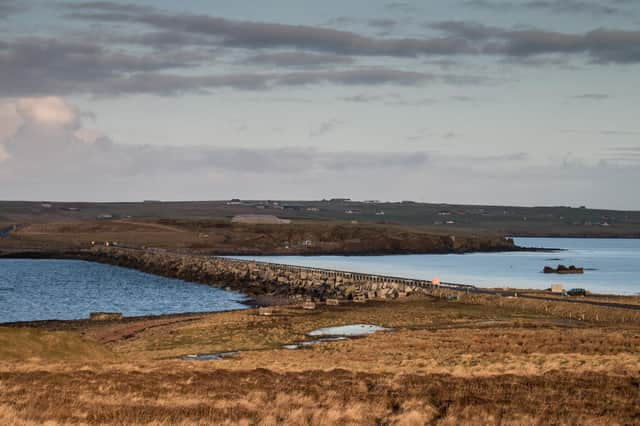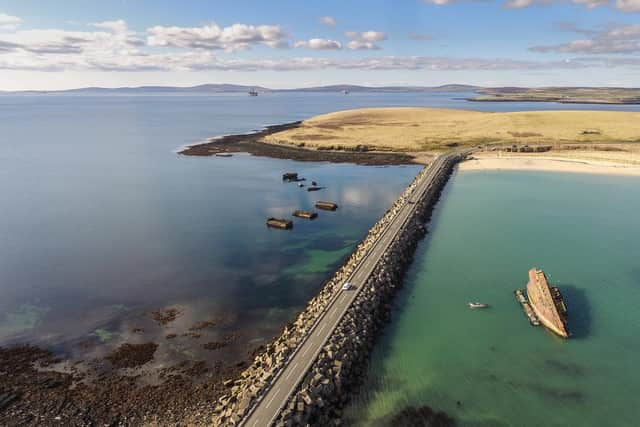Race to save Churchill Barriers amid climate change warning


Now, more than 75 years after they were built in one of the 20th century’s greatest civil engineering feats, authorities in Orkney are seeking national help in finding a long-term solution for the world-famous Churchill Barriers, amid repeated flooding and warnings from experts they are especially vulnerable to the effects of climate change.
The vast causeways were constructed by Italian prisoners of war on the orders of Sir Winston Churchill, the First Lord of the Admiralty, in the wake of the sinking of HMS Royal Oak in a night-time U-boat raid in the autumn of 1939.
Advertisement
Hide AdAdvertisement
Hide AdIt was a tragedy that claimed the lives of 835 men and boys after the Revenge-class battleship was struck by a torpedo salvo. The grim loss also hardened Britain’s resolve to better protect the Home Fleet in its wartime anchorage of Scapa Flow.
In peacetime, the barriers were levelled to allow the construction of roads across the channels splitting the archipelago, establishing a lifeline transport link for island communities as well as a historically significant tourist attraction.
Increasingly, however, they have come under siege from a different enemy in the form of the North Sea’s powerful tidal forces. The link has been repeatedly closed in recent years due to flooding, as well as high winds, resulting in major disruption to those living in South Ronaldsay and Burray.
The Scottish Environment Protection Agency’s (SEPA) draft flood risk management strategy for Orkney also identifies the area around the second barrier as potentially vulnerable, warning the risk of coastal flooding is “likely to increase due to sea level rise caused by climate change”.
Faced with the blight of frequent wave overtopping, officials in Orkney have now resolved to press the Scottish Government for tens of millions of pounds to fund a permanent solution.


Options on the table include replacing the barrier spanning the Holm Sound with a new bridge. The most recent estimate for such a major undertaking put the cost at £24.5m, but some councillors believe the potential bill would be closer to £50m – around two thirds of the council’s annual budget.
Councillors on Orkney Island Council’s development and infrastructure committee have now voted to explore what support is on offer from Edinburgh, floating the idea the barrier project should form part of Transport Scotland’s Strategic Transport Projects Review (STPR2). Given there are no trunk roads on Orkney, the council is wholly responsible for the upkeep of its road network.
Steve Sankey, a councillor who moved from Edinburgh to South Ronaldsay with his family where he works as a wildlife tour guide and organic farmer, warned the option of “doing nothing” about the barriers was “politically and practically out of the question”.


Advertisement
Hide AdAdvertisement
Hide AdHe stressed there was “absolutely no reason to suppose” that Orkney would be immune from rising sea levels, and urged both SEPA and the Scottish Government to review capital allocations so as to allow a solution that is “sympathetic” to the barriers’ construction and history.
“These communities are vexed about the decades of inaction and the barriers continue to deteriorate,” he said.
The council took ownership of the barriers from the Ministry of Defence a decade ago. It has since explored installing a tidal energy scheme on the structures to harness the power of the waves using turbines.
Despite initial interest from renewable energy developers across Europe in the £200m project, the procurement process ended without any company submitting a firm proposal. The local authority itself conceded the business case for such a venture was “marginal at best”.
James Stockan, the leader of Orkney Islands Council, said authorities have spent decades trying to find long-term solutions for the second causeway, and that there were questions about the long-term integrity of other barriers.
Describing the challenge as both “urgent” and “strategic,” he explained: “We need to make sure the Scottish Government supports us with substantial finances to maintain these barriers or find alternatives.
“It’s just the second barrier, which is exposed. We have slightly more concern about the integrity of the first barrier, so putting up a bridge on one of them is only part of the answer.
“We had Boris Johnson here in the summer, and I told him I expected him to live up to the reputation of Churchill. I was hoping for an immediate response or policy decision, but I didn’t get it.”
Advertisement
Hide AdAdvertisement
Hide AdSEPA’s flood risk strategy estimates that as many as 2,200 homes in Orkney will be at risk of flooding by the 2080s as a result of climate change.
Gavin Barr, the local authority’s executive director of development and infrastructure, has told councillors no “simple fix” for the problems facing the Churchill Barriers, characterising it a “complex and to some degree emotive issue”.
Indeed, while a recent survey of more than 700 households across South Ronaldsay and Burray found that a replacement bridge was the most popular option, it was still only the first preference of 35 per cent of residents, with some cautioning against any move to erase a “huge part of Orkney’s history”.
Two of the barriers were listed by Historic Scotland five years ago, but the causeway earmarked for potential replacement is excluded from the protected status.
Leslie Manson, the council’s depute leader, said “if there was a will and the finances to replace the second barrier with a bridge”, it was a price worth paying. “The other three barriers would still exist as lasting and poignant reminders of the wartime strategy to protect the fleet,” he reasoned.
Come what may, Mr Stockan and others in Orkney are determined to press for funding to ensure that years of inaction come to an end. “Shy boys don’t get sweets,” he explained.
A message from the editor:
Thank you for reading this article. We're more reliant on your support than ever as the shift in consumer habits brought about by coronavirus impacts our advertisers. If you haven't already, please consider supporting our trusted, fact-checked journalism by taking out a digital subscription.
Comments
Want to join the conversation? Please or to comment on this article.